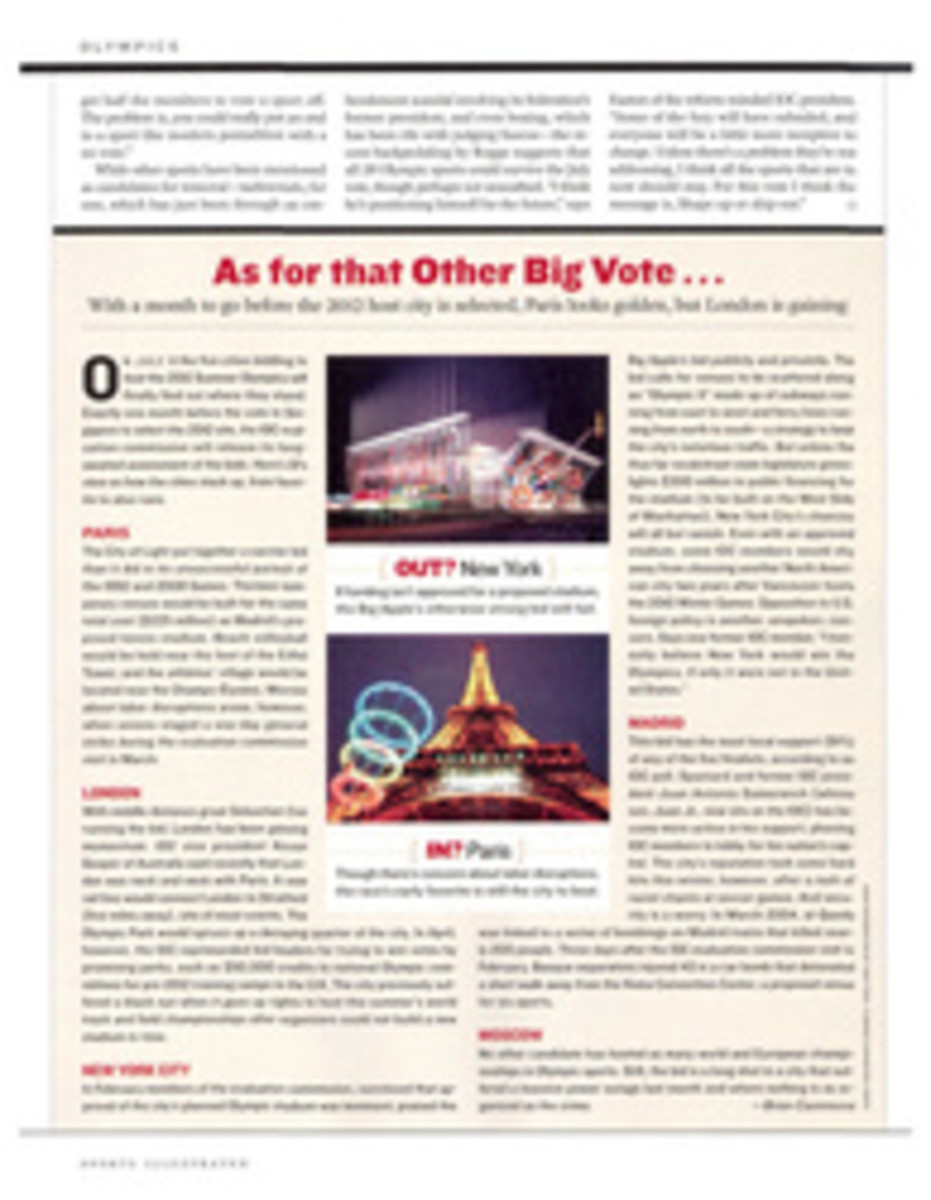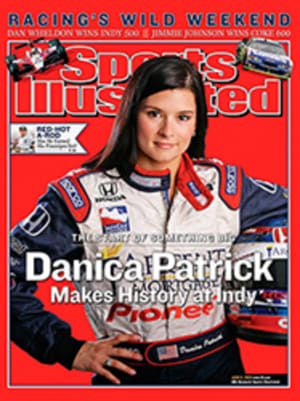
Decent Exposure
DANICA PATRICK is a woman, but in at least one respect she is just like most other racers who pass through the gates of the Indianapolis Motor Speedway: She is an incurable backseat driver. She can't stand to see a gap in traffic go unfilled, an opportunity to advance her position lost. "Go right here, it's clear," she directs from the backseat of a van leaving the Speedway for a photo shoot downtown after Sunday's Indy 500. "And when you get out to 16th, normally they don't let you turn left, so you have to go to the first light and then whip a U-ie right there."
No matter where she sits, the 23-year-old Patrick is all confidence. Her gaze is steady, her handshake memorably firm. She doesn't waste time with things she's not good at, like video games. "If I'm doing something, it's because I feel I can beat everyone; I feel like I can win," she says.
The novelty of a female driver with a shot at winning the most storied car race in America has attracted attention from every quarter of the nation's celebrity-industrial complex. Patrick's agent, Lynn Roach, and the Rahal Letterman Racing team are sorting through a flood of new endorsement and marketing opportunities, including at least one major consumer goods company "that wouldn't normally be associated with male-dominated racing," says team co-owner Bobby Rahal. Websites featuring the provocative FHM photos of Patrick on the hood of a car in various stages of undress received so many hits from newbie race fans last week that several of the sites crashed.
Raven-haired with a steely-eyed demeanor, Patrick wasn't the least bit abashed by the attention. "I always knew if I was fast and was doing things on the track, the media would come around," she said last Thursday, during a meet-and-greet session with the press at which she wore a short blue-jeans skirt. "It's a good story. I don't feel insecure about being girlie. I do as much media as I can because I want this IRL series to be so kick-butt that NASCAR goes, 'Huh?'"
Patrick began her assault on the status quo 13 years ago in Roscoe, Ill., when she started go-kart racing because her little sister, Brooke, wanted to try it. Danica showed promise immediately: Within three months of taking up the sport, she had broken the track record at Sugar River Raceway in southern Wisconsin--yet it offered endless room for improvement. "I loved the way you could see yourself get better in racing," she says. (Improvement is a theme in other, more mundane activities: "I enjoy ironing," she says, "because I like to see the shirts go from wrinkly to flat.")
With her dad, T.J. (owner of a glass company and a former snowmobile, motocross and midget-car racer), serving as her go-kart coach, Patrick learned to pay attention to things other 10-year-olds don't usually think about, such as RPMs, engine temperature and how other kids might be working harder than she was. "I might finish a second and a half ahead of everyone, but it was never good enough," says Patrick. "I could always be better."
In three years she progressed from local to regional to national races. By the time she was 16, in 1998, she had won three World Karting Association class championships and was seeking a new challenge. That year she left T.J., her mom, Bev, and Brooke to move to England and race formula cars against the world's best young drivers. She spent three often lonely years there, but her second-place finish in the 2000 Formula Ford Festival--the best ever by an American at the prestigious event--caught the attention of Rahal, who signed Patrick to race in the U.S.-based Toyota Atlantic series in '03. Her ascent to a slot in this year's Indy 500 was typically swift: Before Sunday she had driven in only four IRL races, her best finish a fourth in Motegi, Japan, in April.
Though Patrick is short on experience, she has everything else she needs for a long run of success in racing. Her fiancé, Paul Hospenthal, 39, a physical therapist, says the 5'1", 100-pound Patrick is "insanely strong" and "the most focused person I've ever met in my life." Patrick's engineer, Ray Leto, adds that she has a quality that sets apart the greatest athletes: an ability to slow events down and pick them apart as they are happening, like a baseball player who can read the rotation of the stitches on a fastball. "She has desire, good judgment and composure under pressure," says Rahal, the 500 winner in 1986. "And she has that thing that only champions have, that chip on the shoulder that says, You don't think I can do it? Come out and take a shot at me."
Patrick has something to prove in every race. "You can go from zero to hero and back again really fast," she says. "You have to stay persistent."
Thus she doesn't define herself within a subcategory of racer, doesn't think of herself as the highest-finishing woman in Indy 500 history. (Her fourth place on Sunday surpassed Janet Guthrie's ninth in the 1978 race.) "If you do that, you settle, you pull back, you say, 'You know what? This is good enough.' And it's never good enough. That's the way I was brought up. Second in the field is not good enough. You have to keep moving. You have to keep thinking, I can be better." --Kelli Anderson
"I don't feel insecure about BEING GIRLIE," says Patrick. "I do as much media as I can because I want this IRL series to be so kick-butt that NASCAR goes, 'Huh?'"
COLOR PHOTO
GEORGE HOLZ/FHM.COM
MODEL DRIVER
Patrick steamed up windshields with her photo spread in FHM, but her heart belongs to fiancé Hospenthal.
COLOR PHOTO
SIMON BRUTY
MODEL DRIVER
Patrick steamed up windshields with her photo spread in FHM, but her heart belongs to fiancé Hospenthal.

